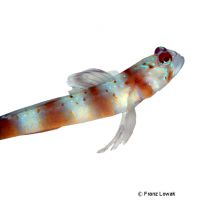Horse-shoe Shrimpgoby (Amblyeleotris arcupinna)
| Horse-shoe Shrimpgoby Amblyeleotris arcupinna | |
|---|---|
| Name | Horse-shoe Shrimpgoby |
| Name Lat. | Amblyeleotris arcupinna |
| Family | Gobies |
| Family lat. | Gobiidae |
| Order | Gobies |
| Order lat. | Gobiiformes |
| Origin | Western Pacific |
| Habitat | Reefs |
| Diet | Planktivore |
| pH | 8.1-8.4 |
| Hardness | 8-10 °KH |
| Behavior | Peaceful |
| Keeping | Pair with pistol shrimp |
| Reef Compatible | Yes |
| Care Level | Moderate |
| Life Span | 5-8 years |
| Protection | No |
| Metric Units | |
| Size | 11 cm |
| Temperature | 22-28 °C |
| Salinity | 33-36 ‰ |
| Aquarium | ~ 200 l |
| US Units | |
| Size | 4" |
| Temperature | 72-82 °F |
| Salinity | 1.020-1.025 sg |
| Aquarium | ~ 50 gal |
Distribution and habitat
The range of the horseshoe watchman goby is the tropical western Pacific around New Guinea. They inhabit burrows in the sandy, gravel-rich zones of shallow reefs protected from strong surf at depths greater than 20.
Maintenance
They need an aquarium with a reef structure that offers numerous hiding, resting and covering possibilities, with living stones that act like a biological filter and free sand areas with a graveable, at least 6 cm deep substrate of fine to medium coral sand
Only calcareous, heavy metal-free sands, gravels, stones or sea sand of various grain sizes may be used as substrate. Filters, skimmers and heaters are necessary to ensure water quality, as well as pumps to simulate tides, swells and bottom currents. Lighting must correspond to the species-appropriate day-night rhythm of the animals
| Salinity: 33-36 ‰ | pH value: 8.1-8.4 |
| Carbonate hardness: 8-10 °KH | Nitrate content: 2-8 mg/l |
| phosphate content: 0.01-0.1 mg/l | nitrite content: 0.0-0.05 mg/l |
For salinity, an average value should be aimed for, which may only vary slightly by +/- 0.5 ‰. Ammonia and ammonium must not be measurable. Special attention must be paid to constantly good water quality.
Diet
In nature they feed mainly on zooplankton. The feed change usually succeeds without problems. The food supply should consist of a combination of live and frozen food, such as small mysis, artemia, bosmids and cyclops, with chopped shrimp and crab meat or a commercially available, vitamin-enriched, frozen food mix for planktivores. High-quality flake and granulated food is also often accepted after an acclimation period
It is recommended to feed small portions several times a day. Regular and varied feeding promotes health and increases resistance.
Behaviour and compatibility
One goby should always be kept with the corresponding firecracker. It is recommended to keep a pair of gobies together with a pair of firecrackers and to put them into the aquarium at the same time. The firecrackers share their living burrows with the gobies and usually stay together in symbiosis for life. They can be well socialized with calm, peaceful fish.
Sex dimorphism
With some experience, the sexes can be identified by their genital papillae.
Reproduction and breeding
There are no known reports of successful breeding in the aquarium
Important
Firecrackers usually build living burrows under large, flat-topped rocks, which they inhabit together with the gobies. When hunting for plankton, the fish appear to hover in front of the entrance to their burrow, into which they retreat in a flash when threatened. In the evening the crayfish close the cave entrance after the goby has slipped in.
As coral reef dwellers, they should not be kept in a fish-only aquarium
If different species are kept together, care should be taken to ensure that the fish match each other in terms of water quality and temperature requirements and social behavior, and that the setup meets the needs of all species kept together. New fish to be introduced must be acclimated slowly to the water in the aquarium
Further literature can be found in your pet store.
References
Text: Werner Winter; Image: Franz Lowak
Source: KUITER, DEBELIUS (2007): Atlas der Meeresfische: Die Fische an den Küsten der Weltmeere, Kosmos Verlag; ENGELMANN (2005): Zootierhaltung - Tiere in menschlicher Obhut: Fische, Verlag Harri Deutsch
- Gemäß § 21 Abs. 5 Tierschutzgesetz idgF
